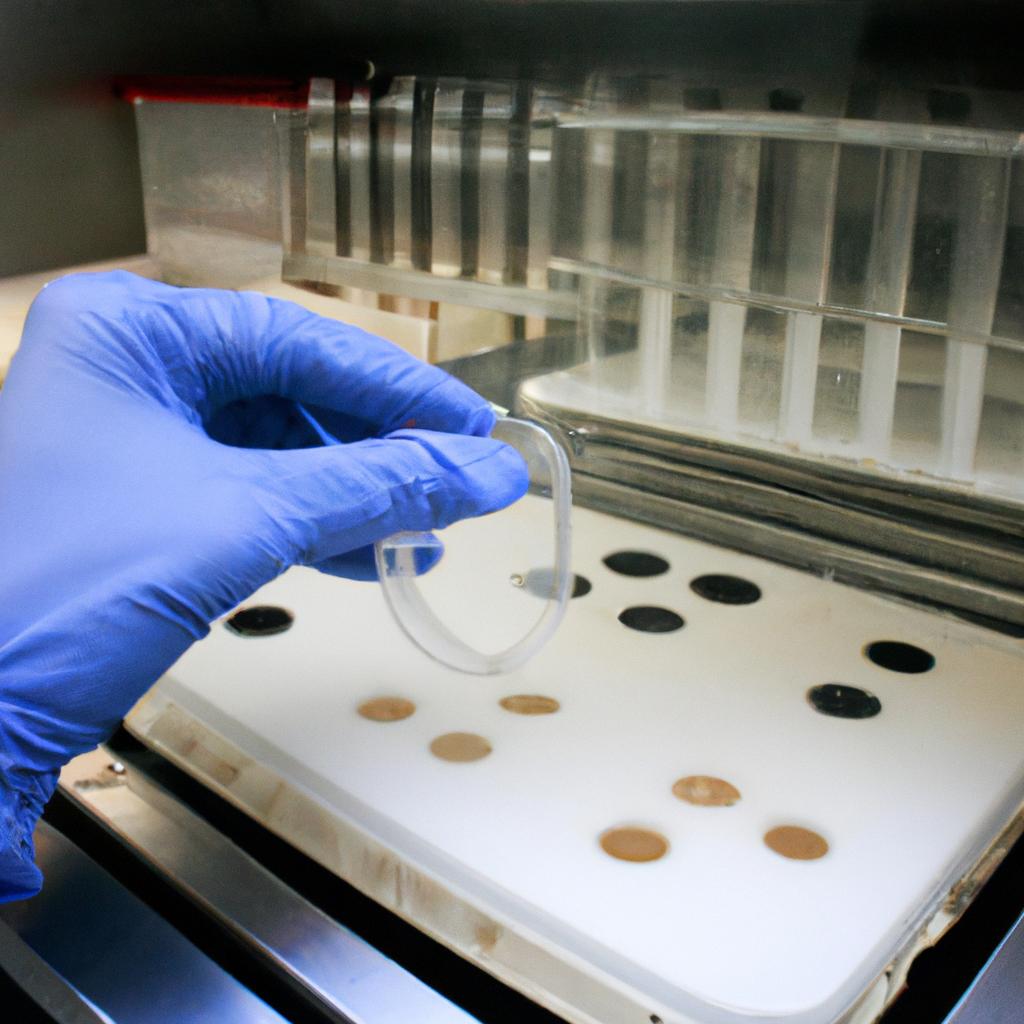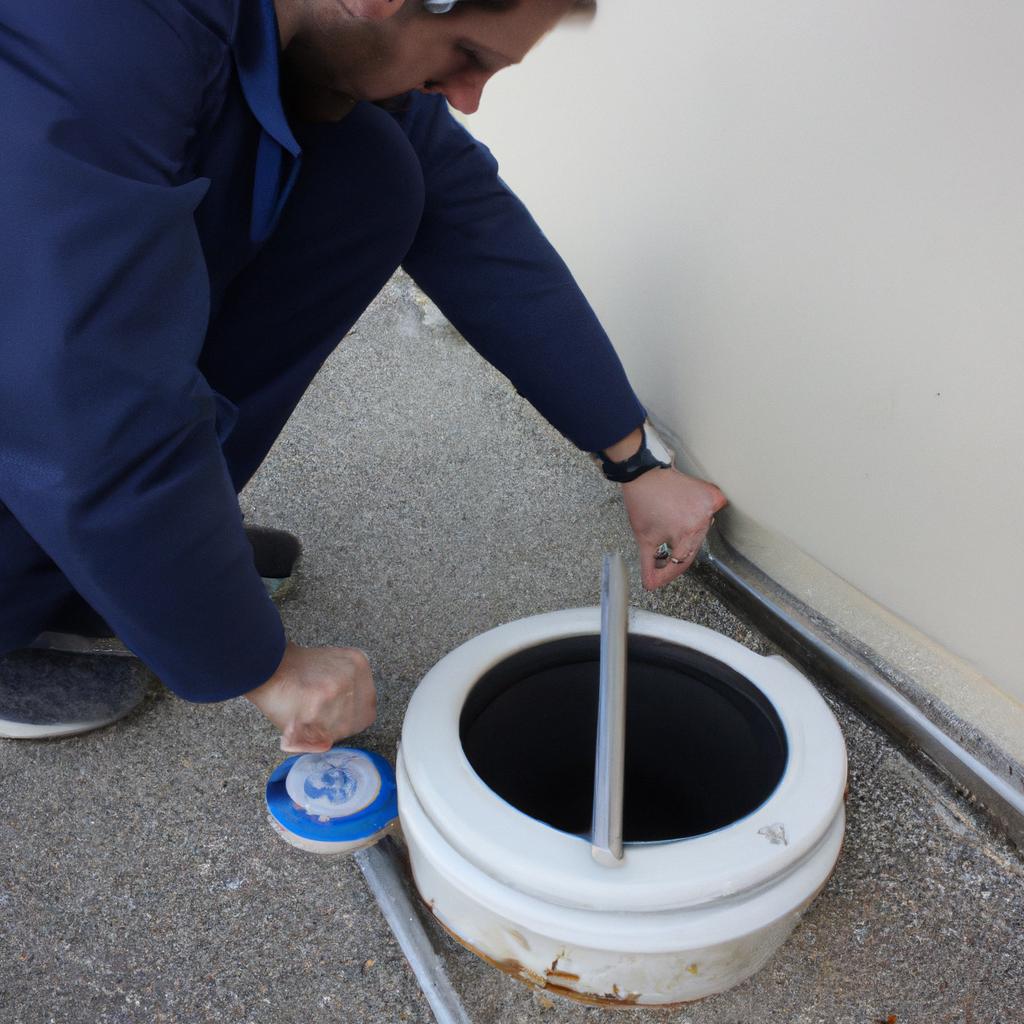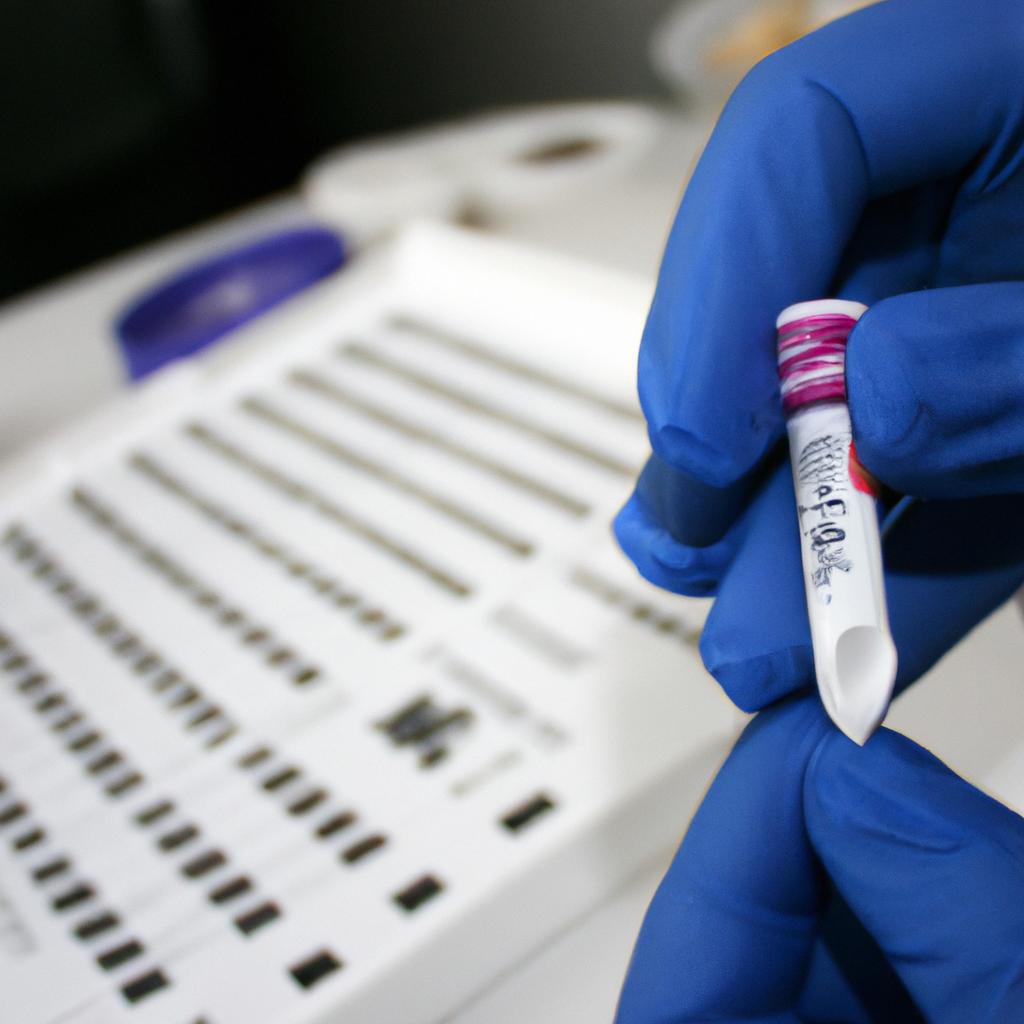Electrolyte analysis plays a crucial role in veterinary clinical pathology, providing valuable insights into the physiological status and overall health of animals. By measuring the concentrations of various electrolytes in body fluids, such as blood or urine, veterinarians can assess fluid balance, acid-base equilibrium, renal function, and other important parameters. For instance, consider a hypothetical case study where a canine patient presents with symptoms suggestive of dehydration. Through electrolyte analysis, clinicians can determine if there is an imbalance in sodium and potassium levels, which may indicate underlying kidney dysfunction or excessive loss of fluids.
A comprehensive understanding of electrolyte analysis is essential for accurate diagnosis and effective management of various medical conditions in veterinary medicine. This article aims to provide a detailed overview of this diagnostic tool within the context of clinical chemistry. It will explore the principles behind electrolyte measurement techniques commonly used in veterinary practice and discuss their significance in interpreting laboratory results. Furthermore, it will delve into the specific roles that different electrolytes play in maintaining homeostasis and how abnormalities in these concentrations can contribute to disease development or progression. Ultimately, this comprehensive overview seeks to enhance our knowledge and appreciation for the critical role of electrolyte analysis in veterinary clinical pathology.
Definition of Electrolytes in Veterinary Medicine
Definition of Electrolytes in Veterinary Medicine
Electrolytes play a crucial role in maintaining the balance and proper functioning of various physiological processes within the bodies of animals. These electrically charged ions are essential for numerous biological functions, including nerve conduction, muscle contraction, pH regulation, osmotic balance, and enzyme activity. To illustrate their significance, let us consider a hypothetical case study involving a dehydrated dog.
In this scenario, a canine patient presents with severe dehydration due to prolonged exposure to high ambient temperatures without access to water. The veterinarian suspects electrolyte imbalances as one of the potential causes underlying the dog’s condition. By analyzing the levels of specific electrolytes such as sodium (Na+), potassium (K+), chloride (Cl-), calcium (Ca2+), and bicarbonate (HCO3-) in the blood serum or plasma, veterinarians can gain valuable insights into the animal’s health status.
To highlight the importance of electrolyte analysis in veterinary clinical pathology further, consider the following key points:
- Maintaining homeostasis: Electrolytes help maintain cellular function by regulating fluid balance both inside and outside cells.
- Nervous system functionality: Proper electrical signaling within neurons is dependent on appropriate concentrations of electrolytes.
- Muscle contractions: Adequate levels of certain electrolytes enable smooth muscle contractions necessary for normal movement and organ function.
- Acid-base balance: Electrolyte composition influences pH levels, which must be tightly regulated for optimal enzymatic reactions and overall metabolic stability.
| Electrolyte | Main Functions |
|---|---|
| Sodium | Regulates extracellular volume |
| Potassium | Maintains resting membrane |
| Chloride | Balances body fluids |
| Calcium | Facilitates muscular contraction |
Understanding these fundamental concepts surrounding electrolyte analysis allows veterinary clinicians to make accurate diagnoses and implement appropriate treatment strategies. The subsequent section will delve into the importance of electrolyte analysis in greater detail, shedding light on how this diagnostic tool aids veterinarians in providing optimal care for their patients.
Importance of Electrolyte Analysis in Veterinary Clinical Pathology
The accurate analysis of electrolytes is crucial in veterinary clinical pathology as it plays a fundamental role in assessing the overall health and wellbeing of animals. Let us consider an example to illustrate its significance: a 5-year-old Labrador Retriever presents with lethargy, weakness, and increased thirst. The veterinarian suspects an underlying electrolyte imbalance due to these clinical signs. In this scenario, conducting a comprehensive electrolyte analysis would help determine the specific imbalance and guide appropriate treatment.
Electrolyte analysis provides valuable information that aids in diagnosing various medical conditions affecting animals. Some key reasons why electrolyte analysis is important include:
-
Monitoring hydration status: Electrolytes such as sodium (Na+), potassium (K+), and chloride (Cl-) are essential for maintaining proper fluid balance within the body. By measuring their concentrations, veterinarians can evaluate an animal’s hydration status accurately.
-
Identifying renal dysfunction: Kidneys play a vital role in regulating electrolyte levels by filtering out waste products from the blood. Abnormalities in electrolyte values can indicate kidney diseases or impairments, allowing early detection and intervention.
-
Assessing metabolic disorders: Electrolytes are involved in multiple metabolic processes within the body. Disturbances in their levels may occur due to endocrine disorders like hyperaldosteronism or hypoadrenocorticism, requiring thorough investigation through electrolyte analysis.
-
Evaluating cardiac function: Imbalances in certain electrolytes, including calcium (Ca2+) and magnesium (Mg2+), can significantly affect heart function. Analyzing these markers helps identify potential cardiac abnormalities and guides appropriate management strategies.
To further emphasize the importance of electrolyte analysis, consider the following table showcasing common clinical presentations associated with specific imbalances:
| Electrolyte | Clinical Presentation |
|---|---|
| Hypernatremia | Excessive thirst, neurological abnormalities |
| Hyponatremia | Weakness, lethargy, seizures |
| Hypokalemia | Muscle weakness, cardiac arrhythmias |
| Hyperkalemia | Cardiac conduction disturbances |
In summary, electrolyte analysis is an indispensable component of veterinary clinical pathology. It aids in diagnosing and managing various medical conditions by monitoring hydration status, identifying renal dysfunction, assessing metabolic disorders, and evaluating cardiac function. The subsequent section will delve into the methods employed for accurate electrolyte analysis in veterinary medicine.
Methods for Electrolyte Analysis in Veterinary Medicine
Section H2: Methods for Electrolyte Analysis in Veterinary Medicine
Transitioning from the previous section on the importance of electrolyte analysis, let us now delve into the various methods employed in veterinary clinical pathology to analyze electrolytes. To illustrate this, consider a hypothetical case of a dog presenting with symptoms suggestive of an electrolyte imbalance. The veterinarian suspects hyponatremia and hyperkalemia due to kidney dysfunction, prompting the need for accurate and timely electrolyte analysis.
In modern veterinary medicine, several techniques are available for electrolyte analysis, each offering specific advantages and limitations. These methods can be broadly categorized into direct measurement techniques and indirect estimation methods.
Direct measurement techniques involve the use of electrodes to measure ion concentrations directly in biological samples such as blood or urine. This approach provides precise results but requires specialized equipment and skilled personnel. Examples include flame photometry for sodium and potassium determination and ion-selective electrode (ISE) methodology for measuring chloride levels.
On the other hand, indirect estimation methods utilize chemical reactions or calculations based on changes in physical properties associated with specific ions. Indirect estimation is often more cost-effective and accessible than direct measurement techniques but may sacrifice some accuracy and precision. A commonly used example is colorimetry, which estimates ion concentration by measuring light absorption after adding reagents that react selectively with target ions.
Considering these approaches, it becomes evident that choosing the most suitable method depends on factors such as availability of resources, urgency of results, desired accuracy level, and sample type (blood or urine). Each technique has its own set of strengths and weaknesses that must be carefully considered by veterinarians when selecting an appropriate method for electrolyte analysis.
To further emphasize the significance of accurate electrolyte analysis in veterinary clinical pathology, here is a bullet point list highlighting key points:
- Timely identification of electrolyte imbalances allows prompt intervention.
- Proper management of electrolytes ensures optimal organ function.
- Precise electrolyte analysis aids in the diagnosis and monitoring of various medical conditions.
- Accurate determination of electrolyte status enhances patient care and improves prognosis.
Additionally, to provide a comprehensive overview, we present a table summarizing commonly used methods for electrolyte analysis in veterinary medicine:
| Method | Principle | Advantages |
|---|---|---|
| Flame Photometry | Emission spectroscopy | High precision |
| Ion-Selective Electrodes | Potential difference measurement | Direct ion concentration measurement |
| Colorimetry | Absorption or emission measurements | Cost-effective |
As we wrap up this section on methods for electrolyte analysis, it is evident that accurate assessment of electrolytes plays a crucial role in diagnosing and monitoring animal health. Now let us move forward to explore reference ranges for electrolytes in veterinary clinical pathology, which will further aid veterinarians in their diagnostic endeavors.
Reference Ranges for Electrolytes in Veterinary Clinical Pathology
Methods for Electrolyte Analysis in Veterinary Medicine provide essential tools for diagnosing and monitoring electrolyte imbalances in animals. In this section, we will explore the various techniques employed in veterinary clinical pathology to measure electrolyte levels accurately.
One commonly used method is Ion-Selective Electrode (ISE) analysis. This technique utilizes a specific electrode sensitive to individual ions such as sodium, potassium, chloride, or calcium. By measuring the potential difference between the reference and ion-selective electrodes, ISE analysis allows for precise quantification of electrolyte concentrations in biological samples. For example, in a recent case study involving a canine patient presenting with signs of dehydration and excessive thirst, ISE analysis revealed significantly decreased sodium levels—a crucial finding that aided in the diagnosis of hyponatremia.
In addition to ISE analysis, Flame Photometry is another frequently utilized method for determining electrolyte concentrations. This technique involves atomizing a sample and analyzing its emission spectrum using a flame photometer. The intensity of light emitted at specific wavelengths corresponds to the concentration of certain elements present within the sample. Flame Photometry offers rapid results and high precision when measuring potassium levels, making it particularly valuable in emergency situations where prompt intervention is necessary.
When performing electrolyte analyses, it is vital to adhere to established reference ranges that define normal values for different animal species. These ranges enable clinicians to interpret laboratory findings accurately and identify deviations from optimal health status promptly. Here are some key points regarding reference ranges:
- Reference ranges vary among species due to physiological differences.
- Age can influence electrolyte levels; therefore, age-specific reference intervals should be considered.
- Certain factors like breed or reproductive status may also impact normal range values.
- Laboratories must validate their own reference ranges based on population studies conducted on healthy animals.
To further illustrate these concepts, consider the following table displaying typical reference ranges for selected electrolytes in dogs:
| Electrolyte | Reference Range |
|---|---|
| Sodium | 138-152 mmol/L |
| Potassium | 3.7-5.8 mmol/L |
| Chloride | 102-118 mmol/L |
| Calcium | 2.1-2.9 mmol/L |
Understanding the methods and reference ranges used in electrolyte analysis is crucial for accurate diagnosis and effective treatment of veterinary patients.
[Transition Sentence] Building upon our knowledge of electrolyte analysis techniques, let us now explore the frequent occurrence of common electrolyte imbalances in veterinary patients.Common Electrolyte Imbalances in Veterinary Patients
When it comes to veterinary medicine, electrolyte imbalances are frequently encountered. One such example is a case involving an older cat presenting with lethargy and decreased appetite. Upon laboratory evaluation, the cat showed significant hypokalemia (low potassium levels) and hypercalcemia (high calcium levels). This case highlights the importance of understanding common electrolyte imbalances in veterinary patients.
To fully grasp these imbalances, it is essential to consider various factors that can contribute to their development. These may include renal dysfunction, endocrine disorders (such as Addison’s disease or hyperparathyroidism), gastrointestinal diseases affecting absorption, or medications altering electrolyte homeostasis. By recognizing these underlying causes, veterinarians can better manage and treat affected animals.
Here are some key points regarding common electrolyte imbalances in veterinary medicine:
- Hypokalemia: Low potassium levels can lead to muscle weakness, cardiac arrhythmias, and even paralysis if left untreated.
- Hyperkalemia: High potassium levels may result from impaired kidney function or conditions like acute kidney injury or urinary obstruction.
- Hyponatremia: Reduced sodium concentrations can be caused by conditions such as congestive heart failure or syndrome of inappropriate antidiuretic hormone secretion (SIADH).
- Hypernatremia: Elevated sodium levels often occur due to water deprivation or excessive loss of fluids without appropriate replacement.
| Electrolyte | Normal Range | Clinical Significance |
|---|---|---|
| Sodium (Na+) | 135-145 mmol/L | Maintains osmotic balance; crucial for nerve impulse transmission |
| Potassium (K+) | 3.5-5.8 mmol/L | Essential for proper cardiac and skeletal muscle function |
| Calcium (Ca2+) | 2.0-3.5 mmol/L | Vital for bone health, blood clotting, and neuromuscular function |
| Chloride (Cl-) | 98-106 mmol/L | Plays a key role in maintaining electrolyte balance and acid-base equilibrium |
Understanding these common electrolyte imbalances is crucial for accurate diagnosis and effective treatment. By interpreting the results of electrolyte analysis, veterinarians can identify underlying conditions and design appropriate management plans to restore proper electrolyte balance.
Transitioning into the subsequent section on “Interpretation and Clinical Significance of Electrolyte Analysis in Veterinary Medicine,” it becomes evident that electrolyte imbalances are not only fundamental indicators of disease but also provide valuable insights into an animal’s overall health status.
Interpretation and Clinical Significance of Electrolyte Analysis in Veterinary Medicine
Section H2: Interpretation and Clinical Significance of Electrolyte Analysis in Veterinary Medicine
In the previous section, we discussed common electrolyte imbalances seen in veterinary patients. Now, let us delve into the interpretation and clinical significance of electrolyte analysis in veterinary medicine.
To illustrate the importance of accurate electrolyte analysis, consider a hypothetical case involving an older dog presenting with lethargy, vomiting, and increased thirst. The veterinarian suspects renal dysfunction and requests an electrolyte panel to aid in diagnosis. Upon analyzing the results, it is revealed that the dog has hyperkalemia (elevated potassium levels) and hyponatremia (reduced sodium levels). These findings can provide valuable insights into potential underlying kidney disease or other systemic disorders.
Interpreting electrolyte analysis requires considering various factors such as age, breed, concurrent medications, diet, hydration status, and any known medical conditions. Understanding both the quantitative values and their clinical implications is crucial for effective patient management. Let us now explore some key points regarding electrolyte analysis:
- Electrolytes play a vital role in maintaining normal physiological functions within the body.
- Imbalances can result from several causes including renal dysfunction, endocrine disorders (such as Addison’s disease), gastrointestinal disturbances (vomiting or diarrhea), medication side effects, dehydration or overhydration.
- Treatment strategies depend on identifying the underlying cause of imbalance along with appropriate fluid therapy.
- Regular monitoring of electrolytes aids in assessing treatment response and guiding further therapeutic interventions.
To summarize this information concisely, refer to Table 1 below which outlines common electrolytes analyzed in veterinary medicine alongside their respective reference ranges:
| Electrolyte | Reference Range |
|---|---|
| Sodium | 135 – 155 mmol/L |
| Potassium | 3.5 – 5 mmol/L |
| Chloride | 95 – 110 mmol/L |
| Calcium | 2.1 – 3 mmol/L |
In conclusion, electrolyte analysis is a valuable tool in veterinary clinical pathology. Accurate interpretation of the results helps diagnose and manage various medical conditions affecting animals. By closely monitoring electrolyte balance and promptly addressing any imbalances, veterinarians can ensure optimal patient care.
Table 1: Reference ranges for common electrolytes analyzed in veterinary medicine.
 Vet Clin Path Journal
Vet Clin Path Journal



